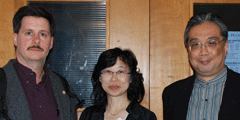
The Visiting Japanese Scholar program enables the Japanese literature faculty to provide students with the experience of studying at a Japanese university without ever having to leave Seattle. It brings renowned scholars to UW for short periods of intense intellectual exchange. Prof. Atkins notes, “Very few universities in North America do this on a regular basis, so the program is attracting attention from other leading programs seeking to duplicate our success. My colleagues and I were particularly pleased by the opportunity to expand the program this year to the undergraduate level.”
Prof. Sakamoto helped graduate and undergraduate students read through the Ogura Hyakunin Isshu, a classical poetry anthology of 100 poems compiled by Fujiwara no Teika. Prof. Kanechiku cotaught a seminar that focused on poetry from the Shin Kokin Wakashū (c 1205 CE), Futamigaura hyakushū (1186), and Roppyakuban utaawase (The Poetry Match in Six Hundred Rounds) (1193). Amy Elder, a graduate student in classical Japanese literature, notes, “They were always able to answer our questions and elaborate on what we were studying.”
In addition to teaching, in May Prof. Sakamoto gave a talk titled “Variations of Regional Accent in the Japanese Puppet Theater” that explored the function of dialect in jōruri recitations, traditionally associated with Japanese puppet theater. Later in the month, together they led a two-part workshop on waka; Prof. Kanechiku led the first part, which focused on recitation, while Prof. Sakamoto conducted the part on calligraphy and waka. Maki Morita, a graduate student who helped to organize the workshop, states that working with Profs. Kanechiku and Sakamoto brought to life classical forms she has studied most of her academic life. “Waka is the art the enables the realization of the beauty and an awakening of the meaning of Yamato poetic language, while the jōruri style of recitation is the art that transmits living language. They provided an opportunity for us to raise our antennae to sense the allure of Japanese literature and culture that was the source for waka and jōruri.”
Both scholars were particularly impressed with the lively interaction between students and instructors on the UW campus. While Japanese college students engage in close readings just as their counterparts do here, lectures are more common than class discussion. They add that the idea of student-centered learning is not prevalent in Japan. Furthermore, they note that the intellectual exchange promoted by an active schedule of visiting lecturers and the library’s extensive resources also contributes to the campus’ vibrancy.
Profs. Kanechiku and Sakamoto's visit is part of an ongoing program that brings Japanese scholars to teach at the University in the Spring quarter each year. Previous visiting scholars have included Profs. Yoshitaka Hibi of Nagoya University, Minato Kawamura and Haruo Nishino of Hosei University, Kensuke Kôno of Nihon University, Keiko Kanai of Waseda University, and Sumio Rimbara of Kobe University.